公司简介的 翻译
- 格式:doc
- 大小:318.50 KB
- 文档页数:11
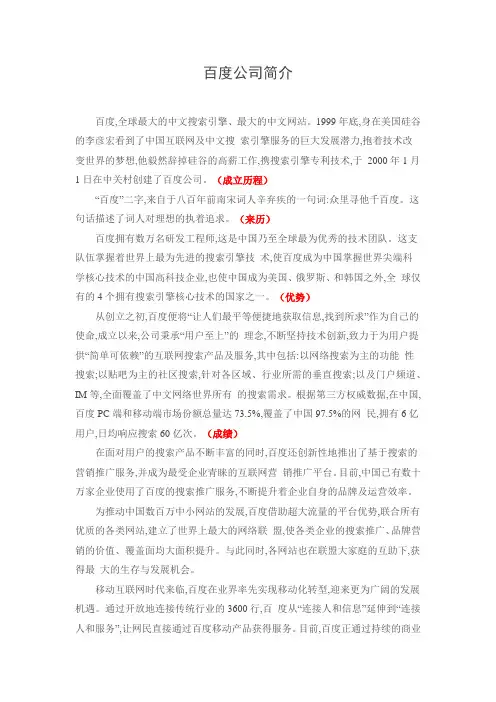
百度公司简介百度,全球最大的中文搜索引擎、最大的中文网站。
1999年底,身在美国硅谷的李彦宏看到了中国互联网及中文搜索引擎服务的巨大发展潜力,抱着技术改变世界的梦想,他毅然辞掉硅谷的高薪工作,携搜索引擎专利技术,于2000年1月1日在中关村创建了百度公司。
(成立历程)“百度”二字,来自于八百年前南宋词人辛弃疾的一句词:众里寻他千百度。
这句话描述了词人对理想的执着追求。
(来历)百度拥有数万名研发工程师,这是中国乃至全球最为优秀的技术团队。
这支队伍掌握着世界上最为先进的搜索引擎技术,使百度成为中国掌握世界尖端科学核心技术的中国高科技企业,也使中国成为美国、俄罗斯、和韩国之外,全球仅有的4个拥有搜索引擎核心技术的国家之一。
(优势)从创立之初,百度便将“让人们最平等便捷地获取信息,找到所求”作为自己的使命,成立以来,公司秉承“用户至上”的理念,不断坚持技术创新,致力于为用户提供“简单可依赖”的互联网搜索产品及服务,其中包括:以网络搜索为主的功能性搜索;以贴吧为主的社区搜索,针对各区域、行业所需的垂直搜索;以及门户频道、IM等,全面覆盖了中文网络世界所有的搜索需求。
根据第三方权威数据,在中国,百度PC端和移动端市场份额总量达73.5%,覆盖了中国97.5%的网民,拥有6亿用户,日均响应搜索60亿次。
(成绩)在面对用户的搜索产品不断丰富的同时,百度还创新性地推出了基于搜索的营销推广服务,并成为最受企业青睐的互联网营销推广平台。
目前,中国已有数十万家企业使用了百度的搜索推广服务,不断提升着企业自身的品牌及运营效率。
为推动中国数百万中小网站的发展,百度借助超大流量的平台优势,联合所有优质的各类网站,建立了世界上最大的网络联盟,使各类企业的搜索推广、品牌营销的价值、覆盖面均大面积提升。
与此同时,各网站也在联盟大家庭的互助下,获得最大的生存与发展机会。
移动互联网时代来临,百度在业界率先实现移动化转型,迎来更为广阔的发展机遇。
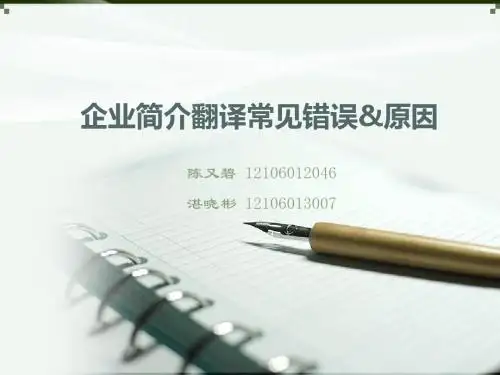
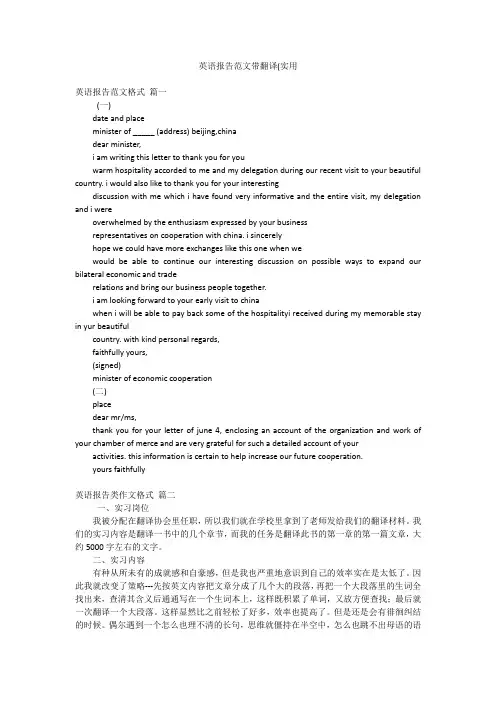
英语报告范文带翻译(实用英语报告范文格式篇一(一)date and placeminister of _____ (address) beijing,chinadear minister,i am writing this letter to thank you for youwarm hospitality accorded to me and my delegation during our recent visit to your beautiful country. i would also like to thank you for your interestingdiscussion with me which i have found very informative and the entire visit, my delegation and i wereoverwhelmed by the enthusiasm expressed by your businessrepresentatives on cooperation with china. i sincerelyhope we could have more exchanges like this one when wewould be able to continue our interesting discussion on possible ways to expand our bilateral economic and traderelations and bring our business people together.i am looking forward to your early visit to chinawhen i will be able to pay back some of the hospitalityi received during my memorable stay in yur beautifulcountry. with kind personal regards,faithfully yours,(signed)minister of economic cooperation(二)placedear mr/ms,thank you for your letter of june 4, enclosing an account of the organization and work of your chamber of merce and are very grateful for such a detailed account of your activities. this information is certain to help increase our future cooperation.yours faithfully英语报告类作文格式篇二一、实习岗位我被分配在翻译协会里任职,所以我们就在学校里拿到了老师发给我们的翻译材料。
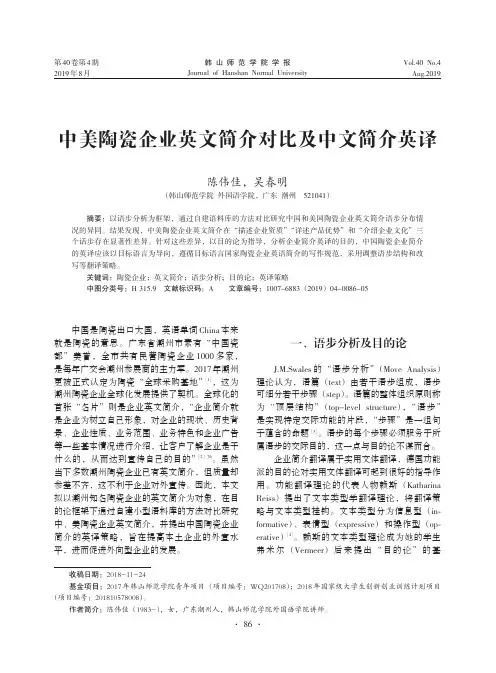
中美陶瓷企业英文简介对比及中文简介英译陈伟佳,吴春明(韩山师范学院外国语学院,广东潮州521041)摘要:以语步分析为框架,通过自建语料库的方法对比研究中国和美国陶瓷企业英文简介语步分布情况的异同。
结果发现,中美陶瓷企业英文简介在“描述企业资质”“详述产品优势”和“介绍企业文化”三个话步存在显著性差异。
针对这些差异,以目的论为指导,分析企业简介英译的目的,中国陶瓷企业简介的英译应该以目标语言为导向,遵循目标语言国家陶瓷企业英语简介的写作规范,采用调整语步结构和改写等翻译策略。
关键词:陶瓷企业;英文简介;语步分析;目的论;英译策略中图分类号:H 315.9文献标识码:A文章编号:1007-6883(2019)04-0086-05中国是陶瓷出口大国,英语单词China 本来就是陶瓷的意思。
广东省潮州市素有“中国瓷都”美誉,全市共有民营陶瓷企业1000多家,是每年广交会潮州参展商的主力军。
2017年潮州更被正式认定为陶瓷“全球采购基地”[1],这为潮州陶瓷企业全球化发展提供了契机。
全球化的首张“名片”则是企业英文简介,“企业简介就是企业为树立自己形象,对企业的现状、历史背景、企业性质、业务范围、业务特色和企业广告等一些基本情况进行介绍,让客户了解企业是干什么的,从而达到宣传自己的目的”[2]76。
虽然当下多数潮州陶瓷企业已有英文简介,但质量却参差不齐,这不利于企业对外宣传。
因此,本文拟以潮州知名陶瓷企业的英文简介为对象,在目的论框架下通过自建小型语料库的方法对比研究中、美陶瓷企业英文简介,并提出中国陶瓷企业简介的英译策略,旨在提高本土企业的外宣水平,进而促进外向型企业的发展。
一、语步分析及目的论J.M.Swales 的“语步分析”(Move Analysis )理论认为,语篇(text )由若干语步组成,语步可细分若干步骤(step )。
语篇的整体组织原则称为“顶层结构”(top-level structure ),“语步”是实现特定交际功能的片段,“步骤”是一组句子蕴含的命题[3]。
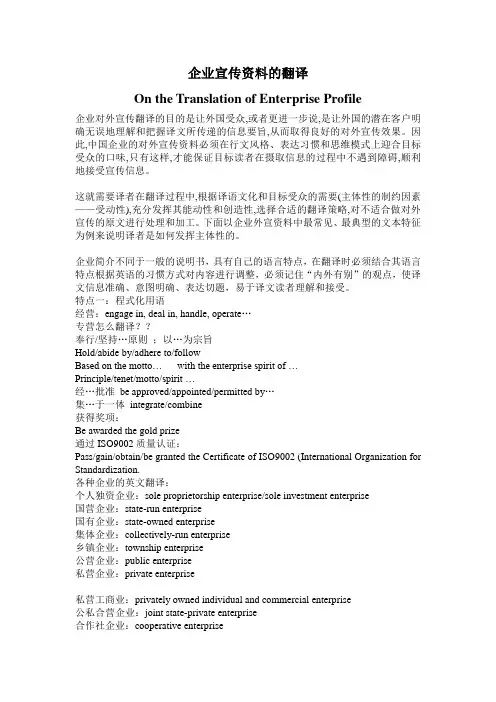
企业宣传资料的翻译On the Translation of Enterprise Profile企业对外宣传翻译的目的是让外国受众,或者更进一步说,是让外国的潜在客户明确无误地理解和把握译文所传递的信息要旨,从而取得良好的对外宣传效果。
因此,中国企业的对外宣传资料必须在行文风格、表达习惯和思维模式上迎合目标受众的口味,只有这样,才能保证目标读者在摄取信息的过程中不遇到障碍,顺利地接受宣传信息。
这就需要译者在翻译过程中,根据译语文化和目标受众的需要(主体性的制约因素——受动性),充分发挥其能动性和创造性,选择合适的翻译策略,对不适合做对外宣传的原文进行处理和加工。
下面以企业外宣资料中最常见、最典型的文本特征为例来说明译者是如何发挥主体性的。
企业简介不同于一般的说明书,具有自己的语言特点,在翻译时必须结合其语言特点根据英语的习惯方式对内容进行调整,必须记住“内外有别”的观点,使译文信息准确、意图明确、表达切题,易于译文读者理解和接受。
特点一:程式化用语经营:engage in, deal in, handle, operate…专营怎么翻译??奉行/坚持…原则;以…为宗旨Hold/abide by/adhere to/followBased on the motto… with the enterprise spirit of …Principle/tenet/motto/spirit …经…批准be approved/appointed/permitted by…集…于一体integrate/combine获得奖项:Be awarded the gold prize通过ISO9002质量认证:Pass/gain/obtain/be granted the Certificate of ISO9002 (International Organization for Standardization.各种企业的英文翻译:个人独资企业:sole proprietorship enterprise/sole investment enterprise国营企业:state-run enterprise国有企业:state-owned enterprise集体企业:collectively-run enterprise乡镇企业:township enterprise公营企业:public enterprise私营企业:private enterprise私营工商业:privately owned individual and commercial enterprise公私合营企业:joint state-private enterprise合作社企业:cooperative enterprise合资企业:joint venture外向型企业:export-oriented enterprise劳动密集型企业:labor-intensive enterprise技术密集型企业:technology-intensive enterprise国有大中型企业:big-and-medium-sized state-owned enterprise亏损企业:money-losing enterprise联合企业:conglomerate工业企业:industrial complex生产型企业:production enterprise三资企业(中外合资企业、中外合作企业、外方独资企业):Sino-foreign joint venturesSino-foreign cooperative enterpriseforeign-funded enterprise特点2:频繁使用标语口号英语注重名称的使用,汉语注重动词的使用;汉语标语常常使用主谓结构,动词标志明显,英语标题名词多,所以汉英翻译实践中要注意转换。
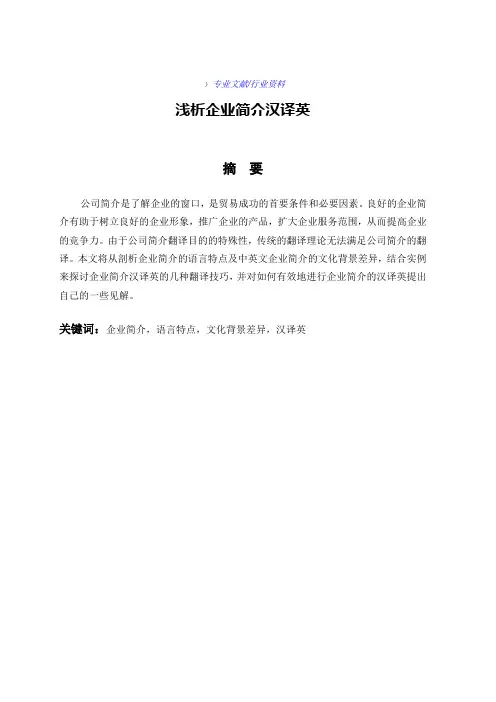
› 专业文献/行业资料浅析企业简介汉译英摘要公司简介是了解企业的窗口,是贸易成功的首要条件和必要因素。
良好的企业简介有助于树立良好的企业形象,推广企业的产品,扩大企业服务范围,从而提高企业的竞争力。
由于公司简介翻译目的的特殊性,传统的翻译理论无法满足公司简介的翻译。
本文将从剖析企业简介的语言特点及中英文企业简介的文化背景差异,结合实例来探讨企业简介汉译英的几种翻译技巧,并对如何有效地进行企业简介的汉译英提出自己的一些见解。
关键词:企业简介,语言特点,文化背景差异,汉译英浅析企业简介汉译英一、引言在全球经济一体化趋势日益增强的今天,越来越多的中国企业意识到公司英文网页建设的必要性和重要性。
大多公司将中文网页翻译成英文,其中首当其中的就是公司简介的翻译。
公司简介犹如公司的一张名片,是客户了解公司的第一面窗口,英文翻译的好坏可能会决定公司是否能吸引顾客和获得客户。
然而由于译者水平,翻译角度以及中西方文化形态、语言习惯和认知模式上的巨大差异,译文中因为没有遵循一定翻译原则而造成的错误和跨文化、跨语言的语用失误时有发生,严重地影响了译文的效果。
因此,针对公司简介语言特点和功能探讨其翻译原则,从而避免公司简介翻译常见错误和译文的语用失误,对于减少误解、达到公司介绍目的和效果具有重大意义。
因此,本文将从企业简介的语言特点,中英文文化背景差异和翻译技巧三方面来进行探讨。
二、公司简介的语言特点和总体翻译原则Peter Newmark(1982)对不同功能语言(Expressive, Informative, Vocative)的翻译进行了分析,列出了这三种功能语言的典型例子,翻译理想风格(‘Ideal’style),翻译侧重点(Text emphasis),翻译聚焦点(Focus),翻译方法(Method),翻译单位(Unit of translation), 语言形式(Type of language), 翻译中意义流失(Losses of meaning), 新词新意使用(New words and meanings),应保留的关键词(Keywords(retain)),对不常见比喻的处理(Usual metaphors),译文相对原文的长度(Length in relation to original)。
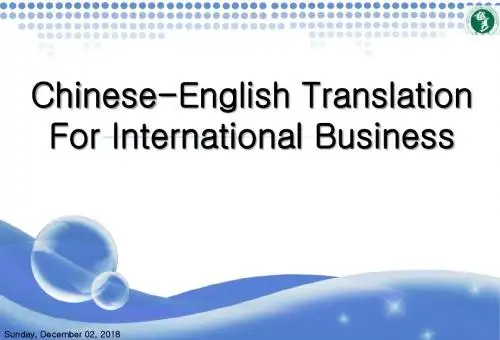
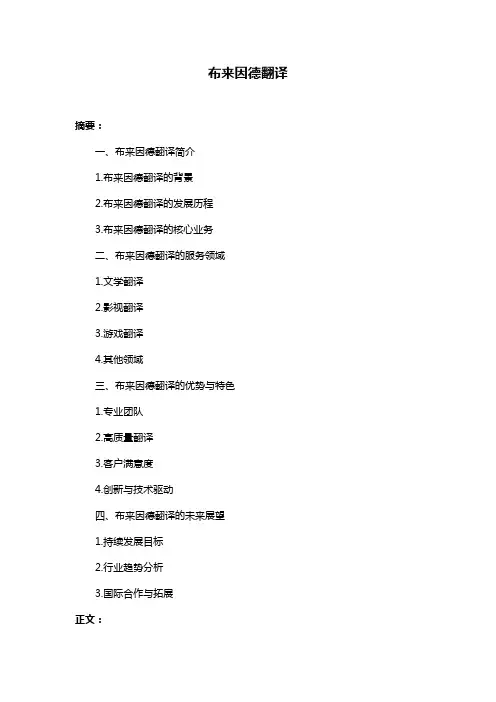
布来因德翻译
摘要:
一、布来因德翻译简介
1.布来因德翻译的背景
2.布来因德翻译的发展历程
3.布来因德翻译的核心业务
二、布来因德翻译的服务领域
1.文学翻译
2.影视翻译
3.游戏翻译
4.其他领域
三、布来因德翻译的优势与特色
1.专业团队
2.高质量翻译
3.客户满意度
4.创新与技术驱动
四、布来因德翻译的未来展望
1.持续发展目标
2.行业趋势分析
3.国际合作与拓展
正文:
布来因德翻译是一家专业的翻译公司,专注于提供高品质的翻译服务。
自成立以来,布来因德翻译已为众多客户提供了优质的翻译解决方案,赢得了客户的信任与好评。
布来因德翻译拥有丰富的行业经验,业务领域广泛。
公司的核心业务包括文学翻译、影视翻译、游戏翻译等。
无论客户需求涉及哪个领域,布来因德翻译都能提供专业的翻译服务。
布来因德翻译拥有一支专业的团队,所有翻译人员均具备相关领域的专业知识,并拥有丰富的翻译经验。
公司注重质量控制,确保每一份翻译稿件都经过严格审校,为客户提供高质量的翻译成果。
同时,公司坚持以客户为中心,关注客户需求,不断提升客户满意度。
在未来的发展中,布来因德翻译将继续坚持专业、质量、客户至上的理念,努力提高自身业务水平,为客户提供更优质的翻译服务。
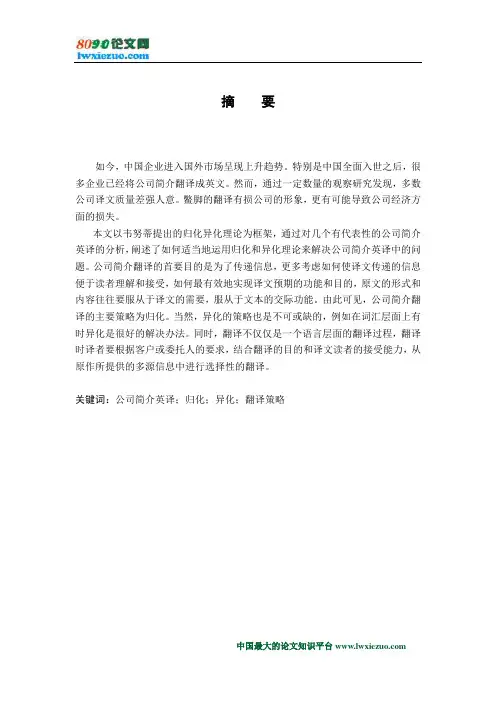
摘要如今,中国企业进入国外市场呈现上升趋势。
特别是中国全面入世之后,很多企业已经将公司简介翻译成英文。
然而,通过一定数量的观察研究发现,多数公司译文质量差强人意。
鳖脚的翻译有损公司的形象,更有可能导致公司经济方面的损失。
本文以韦努蒂提出的归化异化理论为框架,通过对几个有代表性的公司简介英译的分析,阐述了如何适当地运用归化和异化理论来解决公司简介英译中的问题。
公司简介翻译的首要目的是为了传递信息,更多考虑如何使译文传递的信息便于读者理解和接受,如何最有效地实现译文预期的功能和目的,原文的形式和内容往往要服从于译文的需要,服从于文本的交际功能。
由此可见,公司简介翻译的主要策略为归化。
当然,异化的策略也是不可或缺的,例如在词汇层面上有时异化是很好的解决办法。
同时,翻译不仅仅是一个语言层面的翻译过程,翻译时译者要根据客户或委托人的要求,结合翻译的目的和译文读者的接受能力,从原作所提供的多源信息中进行选择性的翻译。
关键词:公司简介英译;归化;异化;翻译策略ABSTRACTToday, an increasing number of Chinese businesses are entering foreign markets. Especially with China‟s full access to WTO, many of these companies have their company profiles translated into English to facilitate the advertising of their goods or services in a foreign market. An examination of these translations has revealed the quality of translations leaves much to be desired. Poor translations can damage the image of a company at best and result in adverse financial consequences at worst.The present paper applies Venuti‟s Domestication and Foreignization as the theoretic framework. With analyzing several representative company profile C-E translations, this thesis tries to discuss how to resolve the problems in company profile translation by proper use of Domestication and Foreignization. Company profile translation mainly aims to offer information, so the apprehension of target readers and acceptability of translated versions should be put at the top place. Domestication is, therefore, an appropriate strategy in business translation, but it dose not always work. Because in some cases, foreignization is more effective, such as in lexical level. Besides, translation is not merely a linguistic process. Guided by the translation brief and taking into account of the translation purpose and the acceptability of the target readers, the translator selects certain items from the source-language.Keywords:company profile translation; domestication; foreignization; translation strategyContents1. Introduction (4)1.1 General introduction. (4)1.2 Research problems. (5)2. Company Profile Translation (6)2.1 Characteristics of Company Profile (6)2.1.1 Clearness (6)2.1.2 Conciseness (7)2.1.3 Preciseness (7)2.1.4 Summary (8)2.2 Criteria of Company Profile Translation (8)2.2.1 Properties of Company Profile Translation (8)2.2.2 Principles for Company Profile Translation (8)2.2.3 Summary (11)3. Domestication and Foreignization (12)3.1 General View on Domestication and Foreignization (12)3.2 Domestication (12)3.3 Foreignization (13)4. The Application of Domestication and Foreignization in C-E Company Profile Translation (15)4.1 The existing problems in company profile translation (15)4.2 Sample analysis of C-E company profile translation (15)4.2.1 Sample analysis 1 (15)4.2.1.1 C-E company profile of Zhongtian Information Technology Co., Ltd (15)4.2.1.2 Existing problems on textual level and revision strategies (16)4.2.2 Sample analysis 2 (17)4.2.2.1 C-E company profile translation of Nice Group and Little Swan Group (17)4.2.2.2 Existing problems in lexical and syntactical level and revision strategies (17)4.2.3 Summary (18)4.3 The Influential Factors of Domestication and Foreignization in Company Profile Translation (18)4.3.1 Cultural Differences (18)4.3.2 Economic Differences (19)5. Conclusion (20)Acknowledgements (21)References (22)1. Introduction1.1 General introductionWith the increasing speed of globalization, the world is becoming smaller and smaller. At the same time China joined in WTO, which makes China be connected more closely to the rest of the world .China‟s intercourses with other countries or regions, especially in business field, are developing rapidly. As a result of that, business translation, a kind of media or tool communication, plays more and more important role in economic area and draws more attention as well as arouses more debates on this topic.Business translation is not only a word-translation activity but also cultural exchanges .The choice of domestication or foreignization is the most important approach in the process of translation, which always puts translator in embarrassing situation.Domestication and foreignization are two basic translation strategies which provide both linguistic and cultural guidance. They are termed by American translation theorist L.Venuti. According to Venuti, the former one refers to “an ethnocentric reduction of the foreign text to target-language cultural values, bring the author back home,” while the latter one is “an ethnodeviant pressure on those (cultural) values to register the linguistic and cultural difference of the foreign text, sending the r eader abroad.”[1]20. Generally speaking, domestication designates the type of translation in which a transparent, fluent style is adopted to minimize the strangeness of the foreign text for target language readers, while foreignization means a target text is produced which deliberately breaks target conventions by retaining something of the foreignness of the original [2]59.Business translation belongs to pragmatic translation and has its own characteristics .Business translation mainly aims to offer information, so the apprehension of target readers and acceptability of translated versions should be put at the top place. Domestication is, therefore, an appropriate strategy in business translation, but it dose not always work. Because in some cases, foreignization is more effective .The research on domestication and foreignization has aroused hot debates; unfortunately, most of them are only focused on linguistic level until recent years when cultural study becomes a hot topic.1.2 Research problems.The present dissertation seeks to address the following research questions:1)Which type of text does the Company Profile Translation belong to?2) What are the problems existed in Company Profile Translation?3) How to resolve these problems by applying domestication and foreignization?2. Company Profile Translation2.1 Characteristics of Company ProfileCompany profile is common English adapted to specific business purposes. Generally speaking, business texts fall into the category of formal style. Business texts commonly serve as a media or tool to the receptors to understand all the information or expressions of the senders. A good business text should be clear and correct enough to arouse no misunderstanding or confusion. As a means of communication, the words used in company profile translation are quite different from those in general English. Due to the particularity of business activities, any negligence may cause big losses in money or in time. Every word, therefore, should be used carefully. Thus in terms of characteristics of company profile, the following points should be paid attention to:2.1.1 ClearnessClearness is the soul of company profile. Clearness means one meaning only, that is, there is no ambiguity or misunderstanding. A business report, a contract, an order, or even a note, should be clear enough to make readers understand well. Ambiguous words, phrases and sentence structures should all be avoided.Clearness requires that the information and meanings be expressed in a simple and direct way. The most proper business language is as such that the readers can understand the meaning immediately. Direct rather than indirect expressions are suitable in business texts, because direct expressions are clearer than indirect expressions, and the former are easier than the latter, thus less misunderstanding or confusion may appear.For example:We would like to know whether you would allow us to extend the time of shipment for 20 days and if you would be so kind as to allow us to do so, kindly give us your reply by fax without delay.It is difficult for readers to grasp the idea because it is too lengthy a sentence expressed in such a tortuous way. It can be rewritten as:Please reply by fax immediately if you will allow us to delay the shipmentuntil April 21.如果同意我方把交货时间延期至4月21日,请速回电。
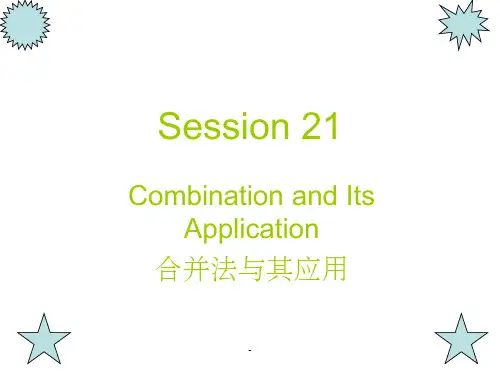
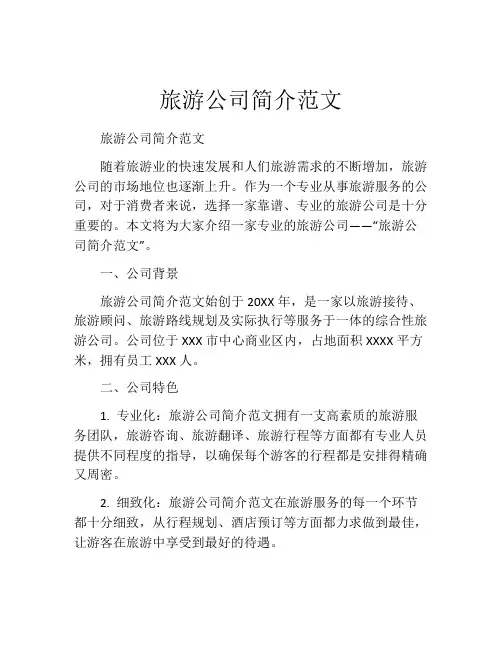
旅游公司简介范文旅游公司简介范文随着旅游业的快速发展和人们旅游需求的不断增加,旅游公司的市场地位也逐渐上升。
作为一个专业从事旅游服务的公司,对于消费者来说,选择一家靠谱、专业的旅游公司是十分重要的。
本文将为大家介绍一家专业的旅游公司——“旅游公司简介范文”。
一、公司背景旅游公司简介范文始创于20XX年,是一家以旅游接待、旅游顾问、旅游路线规划及实际执行等服务于一体的综合性旅游公司。
公司位于XXX市中心商业区内,占地面积XXXX平方米,拥有员工XXX人。
二、公司特色1. 专业化:旅游公司简介范文拥有一支高素质的旅游服务团队,旅游咨询、旅游翻译、旅游行程等方面都有专业人员提供不同程度的指导,以确保每个游客的行程都是安排得精确又周密。
2. 细致化:旅游公司简介范文在旅游服务的每一个环节都十分细致,从行程规划、酒店预订等方面都力求做到最佳,让游客在旅游中享受到最好的待遇。
3. 个性化:旅游公司简介范文注重从客户的角度出发,推出了多种针对不同类型游客的旅游方案,精确满足不同人群的旅游需求。
4. 精益求精:旅游公司简介范文不断探索与改进,不断提升自身的服务品质。
从行程选择、酒店预订、交通安排、景点导览等方面不断进行精益求精,以提供最好的旅游体验。
三、服务内容1. 海外旅游:提供海外旅游相关服务,包括签证办理、酒店预订、航班预订、保险购买、语言翻译等。
2. 国内旅游:提供国内旅游服务,包括路线规划、景点查询、酒店预订、机票预订、车辆租赁等一系列的旅游服务。
3. 私人定制:为有个性需求的游客提供个性化定制专属旅游方案的服务。
4. 旅游定制化服务:针对公司、机构、团体等提供针对性定制企业奖励、会议接待、工作休闲等方面的服务等。
四、服务优势1. 服务细致:在旅行前、旅行中和旅行后都有专人负责,全程跟进。
2. 服务贴心:针对不同旅游服务要求,提供24小时客户服务热线,全天候解答疑问。
3. 服务优质:针对客户的评价,提供不同的奖励激励措施,以提高服务品质。
人力资源有限公司英文翻译简介人力资源有限公司(Human Resources Limited)是一家专业的人力资源服务供应商,致力于为企业提供全方位的人力资源解决方案。
我们拥有经验丰富的翻译团队,提供高质量的英文翻译服务。
无论您需要将企业文档、合同、培训资料或其他任何文件翻译成英文,我们都能够满足您的需求。
为什么选择我们?1.专业团队:我们的翻译团队由经验丰富、精通多种语言的专业译者组成,确保翻译质量和准确性。
2.行业专业知识:我们的团队成员拥有各种行业的专业背景,能够理解并准确翻译行业特定的术语和名词。
3.准时交付:我们严格遵守交付时间,确保您的文件在您预定的时间内完成翻译并交付。
4.保密安全:我们重视客户的隐私和机密性,承诺对所有客户文件进行保密处理。
5.灵活多样:我们提供灵活的服务形式,根据您的需求,可以提供口译、笔译、视频翻译等多种翻译方式。
翻译服务内容我们提供以下翻译服务:1.文档翻译:包括企业文件、技术文档、市场调研报告、产品说明书等。
2.合同翻译:确保合同条款准确无误地翻译成英文,避免翻译误解带来的法律风险。
3.培训材料翻译:将培训课件、培训手册、培训视频等翻译成英文,帮助您的员工更好地理解培训内容。
4.网站翻译:将您的企业网站翻译成英文,帮助您扩大海外市场,吸引更多的国际客户。
5.口译和笔译:根据您的需求,提供现场口译和会议笔译服务,确保您在重要的商务场合中顺畅交流。
我们的优势1.高质量翻译:我们的翻译团队拥有丰富的经验和专业知识,可以保证翻译质量。
2.合理价格:我们提供合理的价格,确保您获得物有所值的翻译服务。
3.客户至上:我们始终将客户的需求放在第一位,与客户保持密切沟通,确保翻译满足客户的期望。
4.快速高效:我们尽最大努力在最短的时间内完成翻译,并保证质量。
联系我们如果您需要英文翻译服务或有任何疑问,请随时联系我们的客服团队:•电话:XXXX-XXXXXXX•邮箱:******************我们期待与您合作,为您提供专业的英文翻译服务!。
Unit 1:Reading B一、课文讲解:TAF ProfileTAF公司简介TAF Co. Ltd was founded in the year 2001 with the objective of providing better and more efficient services to the markets in the African continent and Southeast Asia①. TAF is one of the leading manufacturers of skincare and haircare products②. With its own manufacturing facilities in China and the U.S.A., the company has developed a wide range of products to meet the demands of its international customers③. TAF products are extremely popular in their current markets, and the company is now looking to further expanding its customer base throughout the world④.难点讲解:①Co.,Ltd:是Company Limited 的缩写形式,意思是“有限责任公司”或“股份有限公司”,简称为“有限公司”。
例如:TAF Co. Ltd :TAF有限公司。
found:【及物动词】建立。
be founded in the year 2001:建立于2001年。
Objective:【名】目的,目标,主旨。
with the objective of ...:旨在......。
本句翻译:TAF有限公司2001年建立,旨在为非洲和东南亚市场提供更好更有效的服务。
双语网站建设常用的词语和短语的翻译英文English以下为导航条上部分按钮的翻译网站导航/网站地图Sitemap关于我们About Us公司简介Profile / Company Profile公司设备Equipment公司荣誉Honors / Glories企业文化Culture产品展示Products企业资质Credentials员工福利Employee benefits营销网络Sales Network组织机构Organizational Chart合作加盟Join Us / Cooperation技术力量Technology领导/总经理/董事长致辞1) Leader`s /GM’s/Chairman’s Speech2) Message from XX发展历程History工程案例Cases / Projects业务范围Business Scope分支机构Branches供求信息S&D / Trade Thread 经营理念Business Philosophy产品销售Sales联系我们Contact Us信息发布News返回首页Home产品定购Order留言信息Message information客户留言Message Board客户服务-(Customer) Service售后服务-After-sale Service质量保证-Warranty(质量控制-QC)服务承诺-Service Promise社区Community招聘/求贤纳士Jobs / Join Us企业论坛Forum / BBS下载中心Download Center后台管理Webmaster企业邮局Mailbox客户中心Customer Center客户反馈Customer Feedback以下为普通页面按钮的翻译分类浏览Sorted Browse电子商务E-Business公司实力Strength版权所有Copyright友情连结Hot links应用领域Applications人力资源HR行业新闻Trade news行业动态Trends招商引资Investment招标Bidding业绩Achievements大事记Events动态信息Trends你是如何知道我们的? How did you hear about us? 术语Terms and Conditions使用条款Terms of Use隐私条款Privacy Statement / Privacy (Policy) 三维全景图3D Panorama疑难解答FAQ分类浏览Category专利产品Patented Products样板工程Sample Projects我们的承诺Pledge; Our Commitment当前位置Current Position问卷调查Questionnaires品质政策Quality Policy综合实力General Strength文化生活Cultural Life办公环境Work Environment设备展示Equipments厂房厂貌Photos厂房设备Workshops & Equipments插件Plug-in网站首页上的常用短语-Home(page)进入-Enter跳过动画-Skip你是第几位访问者-You are the visitor of No. __.本页面使用FLASH技术,如未看到动画请先下载FLASH插件,或直接进入。
公司介绍 华为是全球领先的信息与通信解决方案供应商。我们围绕客户的需求持续创新,与合作伙伴开放合作,在电信网络、企业网络、消费者和云计算等领域构筑了端到端的解决方案优势。我们致力于为电信运营商、企业和消费者等提供有竞争力的 ICT 解决方案和服务,持续提升客户体验,为客户创造最大价值。目前,华为的产品和解决方案已经应用于170 多个国家和地区,服务全球1/3的人口。
我们以丰富人们的沟通和生活为愿景,运用信息与通信领域专业经验,消除数字鸿沟,让人人享有宽带。为应对全球气候变化挑战,华为通过领先的绿色解决方案,帮助客户及其他行业降低能源消耗和二氧化碳排放,创造最佳的社会、经济和环境效益。 核心价值观
为客户服务是华为存在的唯一理由,客户需求是华为发展的原动力。我们坚持以客户为中心,快速响应客户需求,持续为客户创造长期价值进而成就客户。为客户提供有效服务,是我们工作的方向和价值评价的标尺,成就客户就是成就我们自己。 更多 > 我们的价值主张
为适应信息行业正在发生的革命性变化,华为围绕客户需求和技术领先持续创新,与业界伙伴开放合作,聚焦构筑面向未来的信息管道,持续为客户和全社会创造价值。基于这些价值主张,华为致力于丰富人们的沟通和生活,提升工作效率。与此同时,我们力争成为电信运营商和企业客户的第一选择和最佳合作伙伴,成为深受消费者喜爱的品牌。 更多 > 财务概要
2013年,华为构筑的全球化均衡布局使公司在运营商网络、企业业务和消费者领域均获得了稳定健康的发展,全年实现销售收入人民币239,025百万元,同比增长8.5%。 更多 > 公司治理
公司股东会是最高权力机构,对公司增资、利润分配、选举董事/监事等重大事项作出决策。 更多 > 研究开发 华为在德国、瑞典、美国、印度、俄罗斯、日本、加拿大、土耳其、中国等地设立了16个研究所,进行产品与解决方案的研究开发人员约70,000名(占公司总人数45%)。 更多 > 网络安全
华为将构筑并全面实施端到端的全球网络安全保障体系作为公司的重要发展战略之一。网络安全是一个全球性挑战,只有通过供应商、客户和政策与法律制定者之间的全球合作,才能在应对全球网络安全挑战方面取得显著成绩。我们必须共享知识和经验,务实合作,共同努力,减少技术被滥用所导致的不可预期风险。 更多 > 发展历程
华为于1987年成立于中国深圳。在20多年的时间里,华为全体员工付出艰苦卓越的努力,以开放的姿态参与到全球化的经济竞合中,逐步发展成一家业务遍及全球170多个国家和地区的全球化公司。 更多 > 公司年报
华为每年发布年报,其中包括由KPMG审计的华为技术合并财务报表。
Corporate Information Huawei is a leading global ICT solutions provider. Through our dedication to customer-centric innovation and strong partnerships, we have established end-to-end capabilities and strengths across the carrier networks, enterprise, consumer, and cloud computing fields. We are committed to creating maximum value for telecom carriers, enterprises and consumers by providing competitive ICT solutions and services. Our products and solutions have been deployed in over 170 countries and regions, serving more than one third of the world's population.
Huawei's vision is to enrich life through communication. By leveraging our experience and expertise in the ICT sector, we help bridge the digital divide by providing opportunities to enjoy broadband services, regardless of geographic location. Contributing to the sustainable development of society, the economy, and the environment, Huawei creates green solutions that enable customers to reduce power consumption, carbon emissions, and resource costs. Core Values Huawei exists to serve customers, whose demands are the driving forces behind our development. We continuously create long-term value for customers by being responsive to their needs and requirements. We measure our work against how much value we bring to customers, because we can only succeed through our customers’ success. More Our Value Propositions
Resonating with the revolutionary changes taking place in the information industry, Huawei continuously innovates to meet customer needs and advance our technological leadership. We openly cooperate with industry partners, focus on building future-proof information pipes, and continuously create value for our customers and society at large. Based on these value propositions, Huawei is dedicated to enriching life and improving efficiency through a better connected world. In addition, we strive to be the first choice and best partner for telecom carriers and enterprise customers while becoming a brand of choice among consumers. More Financial Highlights
In 2013, Huawei's well-balanced presence worldwide helped the company achieve stable and healthy growth in the carrier network, enterprise, and consumer businesses. Annual sales revenue amounted to CNY239,025 million, an 8.5% increase over the previous year. More Corporate Governance
The Shareholders' Meeting is the highest authority within the company, making decisions on major issues such as the company's capital increase, profit distribution, and selection of the members of the Board of Directors/Supervisory Board. More Research & Development
Huawei has over 70,000 product and solution R&D employees, comprising more than 45% of our total workforce worldwide. We have set up 16 R&D centers in countries that include Germany, Sweden, the US, France, Italy, Russia, India, and China. More Cyber Security
Huawei views building and fully implementing an end-to-end global cyber security assurance system as a key corporate strategy and considers cyber security a shared global challenge. Global collaboration among suppliers, customers, and policy and law makers is crucial to meaningfully addressing global cyber security threats. As such, all